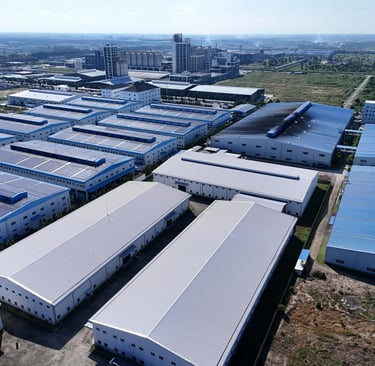Vietnam’s Manufacturing Industry: A Growing Hub for Sustainable and High-Quality Production
12/5/20243 min read


Vietnam's manufacturing sector has emerged as a pivotal component of its economic landscape, contributing approximately 23.88% to the nation's GDP in 2023. (Statista). This growth is underpinned by a strategic location, competitive labor costs, and favorable trade policies, positioning Vietnam as a manufacturing hub in Southeast Asia.
Sustainability Trends
The Vietnamese manufacturing industry is increasingly embracing sustainable practices. Notably, manufacturers lead the sustainable journey, with more than 50% of LEED-certified projects being industrial factories. (Jones Lang LaSalle)
This shift towards sustainability is driven by global environmental standards and consumer demand for eco-friendly products. Initiatives include investing in renewable energy sources, implementing circular economy models, and reducing carbon footprints, contributing to a more sustainable future. (Viettonkin Consulting)
Key Sectors Driving Growth
Several sectors are at the forefront of Vietnam's manufacturing growth:
Electronics: The electronics sector has seen significant foreign direct investment (FDI), with the manufacturing industry attracting over USD 23.5 billion in 2023, accounting for 64.2% of total FDI. (Acclime Vietnam)
Textiles and Garments: After a year of negative growth in 2023, Vietnam's textile and garment sector is showing signs of recovery, with a 4.6% increase in export value, reaching USD 16.5 billion in the first half of 2024. (Vietnam Briefing)
Furniture and Handicrafts: Vietnam's handicrafts export turnover in 2023 reached USD 2.2 billion, up 10.5% over 2022, with the United States being the largest export market, accounting for 35% of total export turnover. (Wikipedia)
Challenges and Opportunities
Despite its growth, the manufacturing sector faces challenges such as supply chain disruptions, skilled labor shortages, and competition from neighboring countries. The Purchasing Managers' Index (PMI) of the manufacturing sector stood at 50.5 in August 2023, indicating a neutral outlook. (Statista)
However, Vietnam's commitment to sustainability and technological adoption presents opportunities to align with global demand for green and ethical manufacturing.
The Future of Vietnamese Manufacturing
Looking ahead, Vietnam's manufacturing industry is poised for further growth, with projections indicating a compound annual growth rate of 3.33% from 2024 to 2029, reaching a market volume of USD 123.9 billion by 2029. (Statista)
The focus is on digital transformation, Industry 4.0 adoption, and sustainable practices, positioning Vietnam as a leader in sustainable manufacturing in the region.
Vietnam's manufacturing industry is evolving into a hub for sustainable and high-quality production, driven by strategic growth, sustainability initiatives, and technological advancements. By addressing current challenges and leveraging opportunities, Vietnam is set to enhance its position in the global manufacturing landscape.
Post-COVID Manufacturing Shifts: Vietnam's Rise Amid China's Dominance
In the wake of the COVID-19 pandemic, Vietnam has experienced a notable increase in manufacturing activities relocating from China. This shift is driven by companies seeking to diversify supply chains and mitigate risks associated with over-reliance on a single country. Vietnam's strategic location, competitive labor costs, and favorable trade policies have made it an attractive alternative for manufacturers.
Foreign direct investment (FDI) in Vietnam's manufacturing sector reflects this trend. In October 2023, FDI rose by 54% year-on-year, reaching $15.3 billion, with nearly 75% directed towards processing and manufacturing industries. (Supply Chain Dive)
Additionally, in the first 50 days of 2023, Chinese companies initiated 45 new ventures in Vietnam, marking the highest investment from a single country during that period. (Horasis)
Despite these developments, China remains the world's manufacturing superpower. As of 2023, China accounted for 31.6% of global manufacturing output, producing goods across diverse sectors such as electronics, textiles, and machinery. (Safeguard Global)
The country's extensive infrastructure, skilled labor force, and established supply chains continue to support its dominant position.
However, China's manufacturing sector faces challenges, including rising labor costs and geopolitical tensions, prompting some companies to explore alternative locations like Vietnam. While Vietnam benefits from this shift, it does not yet match China's scale and capacity in manufacturing. The global manufacturing landscape is evolving, with Vietnam emerging as a significant player, yet China maintains its status as the primary hub.
The post-pandemic era has accelerated the diversification of manufacturing bases, with Vietnam gaining prominence due to increased production relocation from China. Nonetheless, China's comprehensive manufacturing ecosystem ensures its continued leadership in the global market.
Looking for reliable manufacturing partners or suppliers in Vietnam? Reach out to EINVALA.
